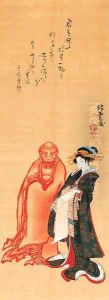Katsushika Hokuun Paintings
Katsushika Hokuun was actually an incorrect rendition of the name of the famous Japanese artist Katsushika Hokusai, who was born in the Edo period of Japan. Born in 1760, Hokusai was best known for his ukiyo-e paintings and woodblock prints, which have had a lasting impact on the development of Japanese art as well as on Western art, particularly the Impressionist movement.
Hokusai began painting at a young age and went through a series of name changes throughout his career, a common practice among Japanese artists seeking to mark significant changes in their life or artistic development. He was known by at least thirty names, but Hokusai is the one under which he gained the most fame. His most famous series of woodblock prints, 'Thirty-six Views of Mount Fuji,' includes the iconic print 'The Great Wave off Kanagawa,' which has become emblematic of Japanese art worldwide. The series was produced when Hokusai was in his seventies, which testifies to his enduring creativity and the peak of his career.
Hokusai's work is characterized by its bold lines, dynamic composition, and vibrant use of color. He drew inspiration from a wide range of subjects, including landscapes, flora and fauna, and the daily life of Japanese people. His influence extended beyond Japan, as his prints were imported to Europe in the mid-19th century, where they were studied by artists such as Vincent van Gogh, Edgar Degas, and Claude Monet.
Despite his success, Hokusai's life was marked by financial struggle, partly due to his habit of spending more money on his art than he earned. He moved residence over 90 times in his life and never settled. Even up until his death in 1849, Hokusai was said to be working on a series of drawings. His last words were reportedly a wish for more time to become a better artist, reflecting his lifelong dedication to his craft. Hokusai's prolific output and his dedication to constantly improving his art have made him a legendary figure in the world of art.

